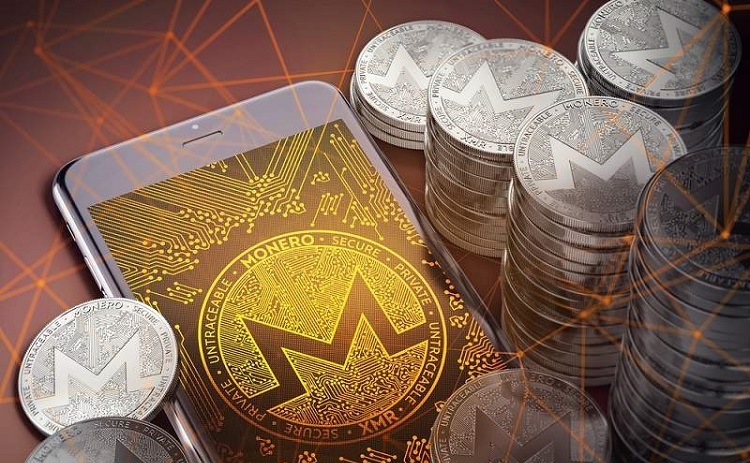You may not know, Monero (XMR) was once the first anonymous coin project in the world and received significant attention from users. It had moments of high popularity in the market, reaching a top 3 market capitalization according to Coinmarketcap statistics. So what exactly is Monero – XMR Coin, what are the highlights of this project, and should you invest in it? If you’re interested, follow the information shared below.
What is XMR coin and Should you Invest in Monero?

What is XMR coin?
Since its inception, the Monero project has received significant support from the community, as well as from Wladimir J. Van der Laan, who maintains Bitcoin Core. As a result, Monero’s market capitalization surged, especially in 2016, when it grew thirtyfold. Part of this growth also came from the Alphabay market – known as the largest black market in the underworld.
Is Monero (XMR) illegal?
Monero (XMR) itself is not illegal; it is a legitimate cryptocurrency that operates within the legal framework of many countries. However, its strong privacy features have made it a favored currency for some individuals who wish to conduct illicit activities due to the difficulty in tracing transactions. This has caused some concern among regulatory bodies.
The legality of using Monero varies by country. While it is legal to buy, sell, or trade Monero in many parts of the world, some countries have imposed restrictions or bans on the use of cryptocurrencies in general, which would include XMR.
Monero was launched with a primary goal: to be as secure and private as possible. To this date, it has the most comprehensive security algorithm among the leading cryptocurrencies.
Monero team believes that privacy is the most critical aspect that cryptocurrencies need to address, and Monero largely focuses on being untraceable and unlinkable.
Many misunderstand this to mean that people want privacy to engage in shady and illegal activities, but that is not the case.
Privacy is also crucial because, with many cryptocurrencies, all information is publicly displayed on the blockchain, and anyone can scan the wallets of others to see where their money is being transferred.
Would you feel comfortable if everyone knew what you were spending your money on?
Or, if you are a business, you might not want your suppliers to know how much money you have, right?
For instance, with credit cards, the companies do not disclose information, and customers are kept confidential. And Monero (XMR) aims to provide privacy just like credit cards do.

Who founded Monero (XMR coin)?
There is not much information available about the people behind the Monero cryptocurrency. On their website, almost all contributors are anonymous.
The main developer known is Fluffypony, whose real name is Riccardo Spagni and is from South Africa.
This project was established on April 18, 2014, originally named BitMonero. The ‘Bit’ prefix was inspired by Bitcoin, and ‘Monero’ means coin in Esperanto. After five days of release, the project was renamed to Monero. This XMR project is known as a fork of CryptoNote and is based on the mechanism of Bytecoin, yet it still has its distinct differences, which are:
- Speed: The target time for each block was previously 120 seconds, but it has now been optimized to 60 seconds.
- Timing: The block emission time has been reduced to half.
- Updates: In the initial Monero project, there were many segments of poor-quality code; the Monero team has rewritten the code to be more optimized and refined.
Monero, because it is not built on Bitcoin’s architecture, cannot take advantage of Bitcoin’s technological advancements. Everything in Monero has to be built from the ground up, which means that transactions will consume more blockchain space than Bitcoin transactions do. Consequently, running a Full Node for Monero can be quite costly.
Basic Information about the XMR
- Token Name: XMR
- Price at Launch: 1 XMR = 2.47 USD
- All-Time High Price: 1 XMR = 480 USD
- Current Price: $ 214.79 (-1.42%)
- Market Cap: $ 3.96 B
- 24h Volume: $ 58.60 M
- Circulating Supply: 18,446,744 XMR
- Max Supply: infinite supply
What is Monero (XMR coin) technology?

The technology behind Monero (XMR coin) is quite unique and focuses on privacy and anonymity, which is achieved through several innovative features:
♦ Ring Signatures: Ring signatures are a type of cryptographic signature that provide privacy for the user. When a transaction is made, the system uses account keys to create a complex signature that appears on the blockchain, concealing the identity of the sender. This is done by combining the sender’s account keys with public keys on the blockchain, making it appear as though the transaction could come from any one of the key owners.
♦ Stealth Addresses: These are one-time, randomly generated addresses used for individual transactions. They protect the actual addresses of the parties in a transaction, adding another layer of privacy. When a transaction occurs, the recipient receives funds to a unique address that can’t be linked back to their public address.
♦ Ring Confidential Transactions (RingCT): This feature, which was implemented in January 2017, adds to the privacy by concealing the amount of XMR that is transferred. With RingCT, the value of each transaction is hidden, making the transaction details completely private.
The combination of these features makes Monero one of the leading cryptocurrencies in terms of privacy and security. Users are assured that their transactions are not only untraceable but also their balances are kept private from the public.
What are the standout features of Monero?
Monero (XMR) is known for its strong privacy features. Here are some of its standout characteristics:
- Privacy and Anonymity: Monero uses advanced cryptography to ensure that all transactions remain completely private and untraceable. Unlike Bitcoin, where transactions are transparent and traceable, Monero’s technology obfuscates the sender, receiver, and amount of every transaction.
- Ring Signatures: This feature mixes a user’s account keys with public keys obtained from Monero’s blockchain to create a ‘ring’ of signers, making it exceptionally difficult to pinpoint the actual signer of a transaction.
- Stealth Addresses: These are one-time addresses, generated randomly for each transaction on behalf of the recipient. This prevents linking transactions to the actual recipient’s published address.
- Ring Confidential Transactions (RingCT): This feature hides the transferred amount. Launched in January 2017, RingCT allows for hidden transaction amounts, adding another layer of privacy.
- Fungibility: Due to Monero’s privacy features, its coins are fungible, which means one Monero will always be equal to another. This makes it impossible to blacklist or discriminate against specific coins, which can happen with more transparent cryptocurrencies.
- Dynamic Scalability: Unlike Bitcoin, Monero doesn’t have a pre-set block size limit. This theoretically means it can accommodate more transactions as needed, aiding scalability.
- ASIC Resistance: Monero aims to remain accessible to individuals using consumer hardware and has made efforts to remain resistant to mining with Application-Specific Integrated Circuits (ASICs), which are commonly used for mining cryptocurrencies like Bitcoin.
- Community and Development: Monero has an active community and development team that focuses on privacy and security. The project is open-source, and its development is funded by donations from its community.
- Decentralization: Monero puts a strong emphasis on decentralization, which reduces the risk of censorship or regulatory control.
These features collectively make Monero one of the top privacy-centric cryptocurrencies available, attracting users who prioritize transaction confidentiality and security.
Monero (XMR) Pros and Cons

Is XMR a good investment?
XMR, or Monero, has been known for its strong privacy features, which differentiate it from many other cryptocurrencies like Bitcoin and Ethereum that have transparent blockchains. The potential of XMR, as with any cryptocurrency, can be assessed from various angles:
-
Privacy Features: If privacy continues to be a significant concern for users, XMR’s robust privacy features may keep it in demand.
-
Regulatory Climate: Stricter regulations on cryptocurrencies may either harm privacy coins due to their anonymous nature or, conversely, boost their popularity among those seeking financial privacy.
-
Adoption and Use Cases: The more widespread the adoption of XMR for legitimate purposes, the more potential it has. Its use in darknet markets has been a controversial aspect that attracts some users while repelling others.
-
Development Activity: The ongoing development and the community’s support play a crucial role in the coin’s innovation and problem-solving capacity, which can influence its potential.
-
Market Dynamics: As with any asset, market trends, investor sentiment, and broader economic factors can influence the price and potential of XMR.
-
Competition: The emergence of new privacy coins or privacy solutions for existing non-privacy coins could impact Monero’s market position.
Related post:
Here is all the information about what XMR Coin is and the Monero project that that you may refer to. Hope this information will be helpful to you in your investment process and allow you to understand more about XMR. Don’t forget to contribute your opinions in the comment section below to help our article be more complete, accurate, and objective.
















